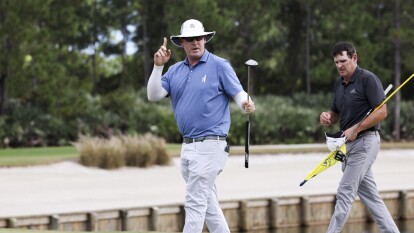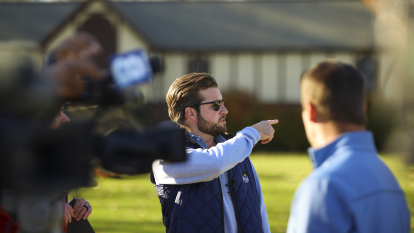BETHESDA, Md. – You will find everything in place to prepare you for a round of golf when you’re at Congressional Country Club. Immaculate practice range, exquisite chipping area, expansive putting green, state-of-the-art performance center. Boxes all checked.
Most of all, of course, there is a demanding, but fair golf course with its “bones” dating back more than 100 years and its pristine shine owed to Andrew Green’s renovation vision.
We’re back in action and the sun is out for Round 2.#SrPGAChamp pic.twitter.com/Dywja9GQan
— Senior PGA Champ (@seniorpgachamp) May 23, 2025
Superb, all of it, which is why Congressional remains a must-go-to destination for elite golf competitions. For instance: This week’s 85th Senior PGA Championship, and what’s coming down the road – the 2027 KPMG Women’s PGA Championship, 2030 PGA Championship and the 2037 Ryder Cup.
Only there is more, so much more, especially if you have an appreciation of history and a fondness for the people and events that shaped this country. At Congressional Country Club you are blessed to have a clubhouse one year removed from its centennial and one that offers a breathtaking walk into a veritable time capsule. “It is,” said Billy Andrade, one of 156 competitors in this week’s Senior PGA Championship, “a museum.”
Amen to that, because to accept the notion of Congressional’s clubhouse as a museum is to savor the priceless nuances – architectural molding that is a marvel; floors that creek so beautifully and seem to whisper in your ears that you are moving back in time; stained glass windows that subtly celebrate what is a part of the club, from golf to billiards to bowling to swimming to vintage farmland to polo.

To tour the clubhouse requires a stop at nearly every wall, for tributes are presented to former Head PGA Professionals (Wiffy Cox and Tommy Armour, most notably) and to epic championships held here (most prominently, Ken Venturi’s 1964 U.S. Open).
It is a mesmerizing visit and it grabs your attention less than 100 feet from when you step through the front doors. There inside a large picture frame on the wall is enclosed the signed contracts by 12 men who agreed to pay $1,000 to become founding members. Should you not recognize these 12 names, you likely slept through your high school history classes:
William C. Carnegie; Walter P. Chrysler; Alfred du Pont; Vincent Astor; John T. Underwood; Harvey S. Firestone; A.P. Giannini; T.A. Mellon; Ransom E. Olds; Gustave Pabst; Evans Searle Pillsbury; and John D. Rockefeller.
What accompanies these contracts is a Who’s Who roll call of other industrialists and financiers who agreed to become life members. More Rockefellers, more Mellons, more Guggenheims, but also Robert A. Stranahan, whose son Frank became a dominant amateur golfer; Charlie Chaplin; and James (Diamond Jim) Brady.

All of which dominates your attention, at least until you turn to see a wall that celebrates a foursome of founding life members – Howard Taft, Woodrow Wilson, Warren Harding and Calvin Coolidge. Throw in the plaque that notes how Herbert Hoover was the club’s first president and you have every U.S. President from 1909-1933. Add in that a former U.S. Supreme Court Chief Justice (Taft) was prominent here and you know for certain that you are in a true museum.
“The proximity to politics (Washington D.C. is a mere 12 miles away) is obvious,” said Jason Epstein, PGA Director of Golf and Athletics at Congressional Country Club. “When this club was built in 1924, Herbert Hoover was the Secretary of Commerce.”
A PGA of America Golf Professional, Epstein has strong ties to the game (he played at New Mexico State with 2002 PGA Champion Rich Beem and longtime PGA TOUR caddie Brennan Little, who is in this week’s field at the 85th Senior PGA Championship), but so, too, does he embrace history. So being at Congressional is the ultimate perfect fit.
“How many country clubs have helped win a war?” he asks and therein is a door to a remarkable layer of history at this club. That’s because when the United States entered World War II “the club fell under the control of the government,” said Epstein.
It is a small bronze statue dedicated to Brigadier Gen. William (Wild Bill) Donovan that sits in the entry hallway of the club and helps introduce this story. He oversaw the Office of Strategic Services (OSS) and pretty much turned Congressional Country Club into the personal training grounds for his troops.
“They blew up everything,” said Epstein, alluding to the golf course and the other athletic areas. “The military trained here and ammunition and bags of cement were brought in.”

As he heard Epstein tell the story at a Senior PGA Champions’ dinner Tuesday evening, Jay Haas – a two-time winner – listened with wonderment. “It was fascinating to hear and because I’m only a generation removed from that time, I found it interesting,” said Haas.
Like others in the room, Haas wondered if remnants of that time – meaning ammunition or buildings – were left over. But Epstein explained that once the war ended, the club was given back to the members and it was totally cleaned of all structures and all military training evidence.
What is left over from the time when the OSS controlled Congressional Country Club is a large wooden carving of the iconic United States eagle. Now if you look at any American currency you can see the eagle’s head turned to its right, toward the talon that holds olive branches. Peace.
But inside the venerable Capitol Room upstairs at Congressional, the eagle that hangs on the wall at one end of the room shows the head turned to its left, toward the talon that holds arrows pointed up. War.
It is a fascinating history, yes; but so, too, is it somber, knowing that Congressional Country Club was born just before the Great Depression and was connected in ways to World War II. Haas appreciated Epstein’s history lessons because “I’m 71 and when I see these documentaries on TV of those who made this country, I find them interesting.”
The wait is over.
— Senior PGA Champ (@seniorpgachamp) May 19, 2025
Championship week is here!#SrPGAChamp pic.twitter.com/4RVvjogHsh
Spot on by Haas. Historical documentaries are rich and flavorful. Just like a walk through Congressional Country Club.




